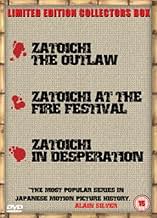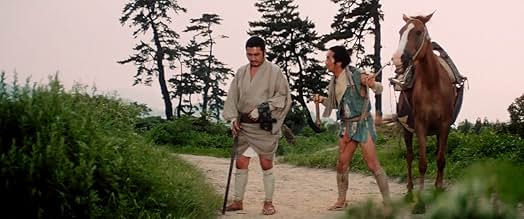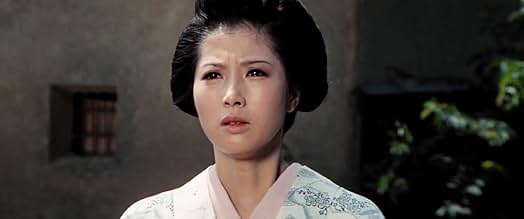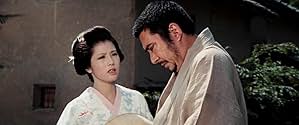IMDb-BEWERTUNG
7,3/10
1615
IHRE BEWERTUNG
Füge eine Handlung in deiner Sprache hinzuZatoichi meets an infamous blind leader of a gangster organization as he contends with a gloomy ronin widower.Zatoichi meets an infamous blind leader of a gangster organization as he contends with a gloomy ronin widower.Zatoichi meets an infamous blind leader of a gangster organization as he contends with a gloomy ronin widower.
Handlung
WUSSTEST DU SCHON:
- WissenswertesThis is the twenty-first of 26 films to star Shintaro Katsu as Zatoichi.
- VerbindungenFollowed by Shin Zatôichi: Yabure! Tôjin-ken (1971)
Ausgewählte Rezension
The following review is an extract from the book "Shintaro Katsu´s Zatoichi: Complete guide to all movies", which is now available on Amazon.
In 1830, in the province of Kanto, a very powerful head of organized crime managed to unify under his command all the clans of the Yakuza. This supreme leader, whom very few have seen, controls with an iron fist illegal businesses such as gambling, prostitution and extortion; and is known throughout Japan as "The Dark Imperial Lord," or "the Shogun of the Underworld".
Zatoichi arrives in that region after witnessing numerous villagers kneeling before an outstanding character transported in palanquin: "Who is that daimyo?" He gets no answer, because it was not a daimyo, but the enigmatic "boss of bosses" and his entourage.
(...)
Together with "Zatoichi 's Pilgrimage" (Kazuo Ikehiro, 1966) this is undoubtedly one of the best episodes in the entire saga of 26 films about Zatoichi (if not directly the best). Made by Kenji Misumi, lead actor Shintaro Katsu participated in the script.
Aesthetic beauty is present throughout the film, and it is worth highlighting a scene in which the mysterious samurai chasing Zatoichi has a kind of flashback nightmare...
In the final scenes, Ichi will have to endure a real hell before confronting the sinister yakuza boss - who is as blind and cunning as he is. But unlike the "Shogun of the Underworld," Ichi is on the side of justice and always denounces hypocrisy and corruption: "We bandits act outside the law, but you behave as if you belonged to royalty..."
In 1830, in the province of Kanto, a very powerful head of organized crime managed to unify under his command all the clans of the Yakuza. This supreme leader, whom very few have seen, controls with an iron fist illegal businesses such as gambling, prostitution and extortion; and is known throughout Japan as "The Dark Imperial Lord," or "the Shogun of the Underworld".
Zatoichi arrives in that region after witnessing numerous villagers kneeling before an outstanding character transported in palanquin: "Who is that daimyo?" He gets no answer, because it was not a daimyo, but the enigmatic "boss of bosses" and his entourage.
(...)
Together with "Zatoichi 's Pilgrimage" (Kazuo Ikehiro, 1966) this is undoubtedly one of the best episodes in the entire saga of 26 films about Zatoichi (if not directly the best). Made by Kenji Misumi, lead actor Shintaro Katsu participated in the script.
Aesthetic beauty is present throughout the film, and it is worth highlighting a scene in which the mysterious samurai chasing Zatoichi has a kind of flashback nightmare...
In the final scenes, Ichi will have to endure a real hell before confronting the sinister yakuza boss - who is as blind and cunning as he is. But unlike the "Shogun of the Underworld," Ichi is on the side of justice and always denounces hypocrisy and corruption: "We bandits act outside the law, but you behave as if you belonged to royalty..."
- alucinecinefago
- 14. Mai 2020
- Permalink
Top-Auswahl
Melde dich zum Bewerten an und greife auf die Watchlist für personalisierte Empfehlungen zu.
- How long is Zatoichi Goes to the Fire Festival?Powered by Alexa
Details
- Erscheinungsdatum
- Herkunftsland
- Sprache
- Auch bekannt als
- Zatoichi Goes to the Fire Festival
- Produktionsfirmen
- Weitere beteiligte Unternehmen bei IMDbPro anzeigen
- Laufzeit1 Stunde 36 Minuten
- Seitenverhältnis
- 2.35 : 1
Zu dieser Seite beitragen
Bearbeitung vorschlagen oder fehlenden Inhalt hinzufügen

Oberste Lücke
By what name was Zatôichi abare-himatsuri (1970) officially released in India in English?
Antwort





























